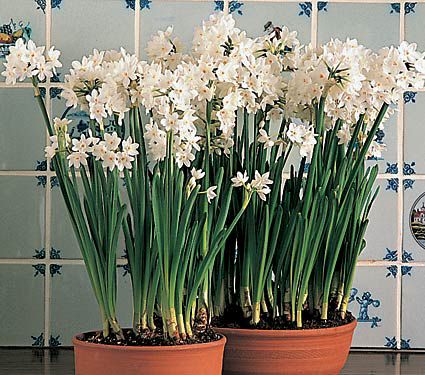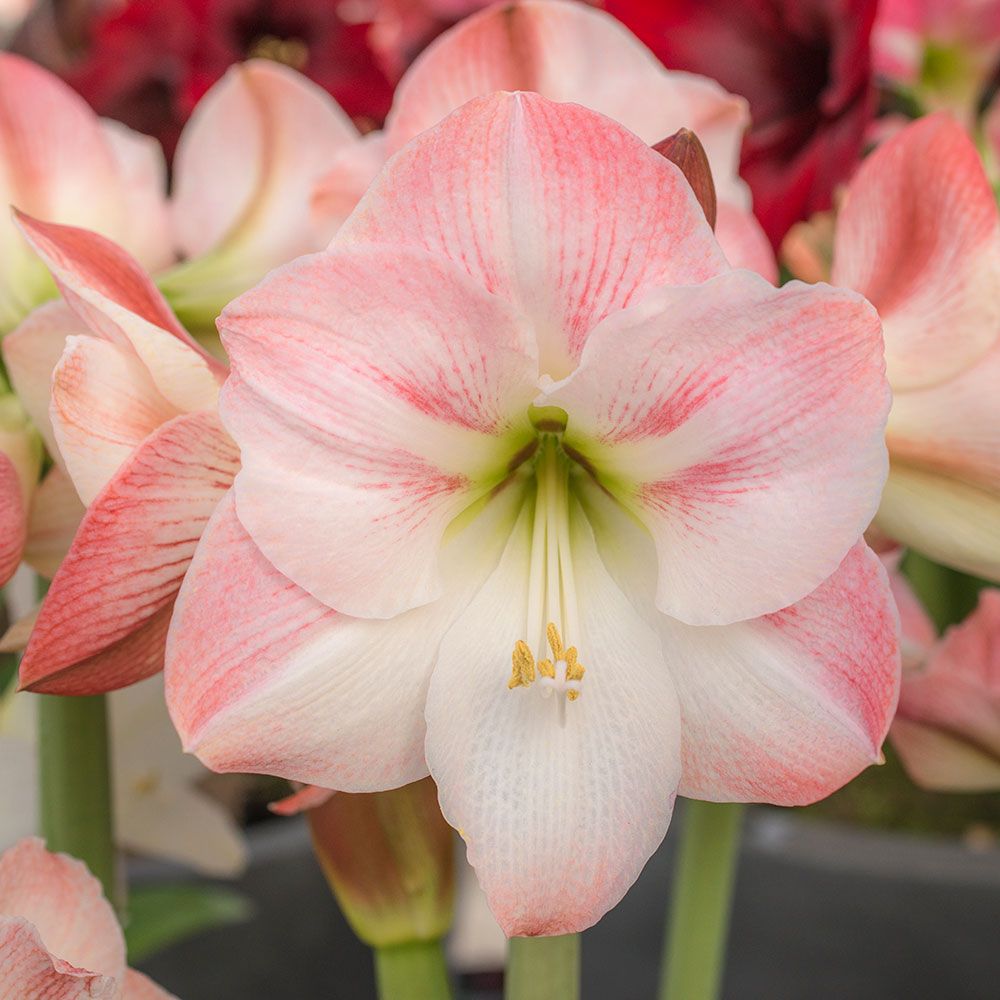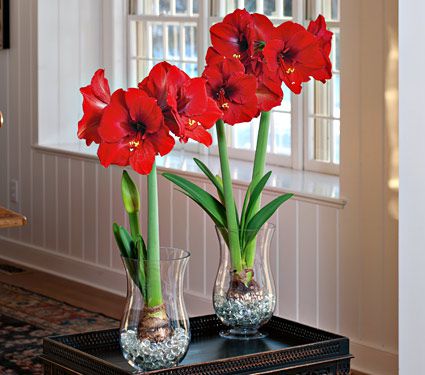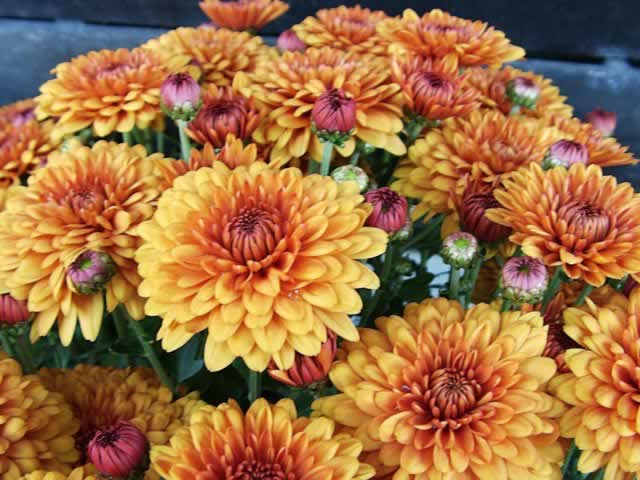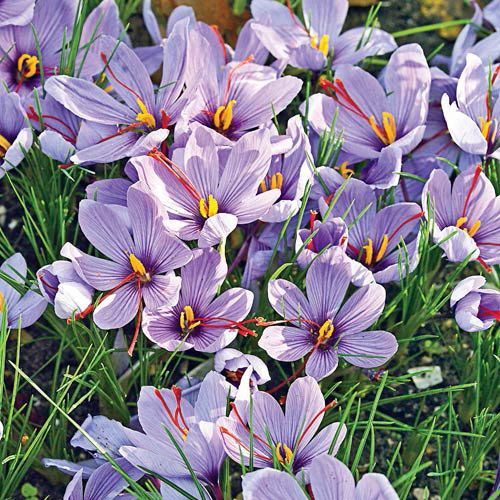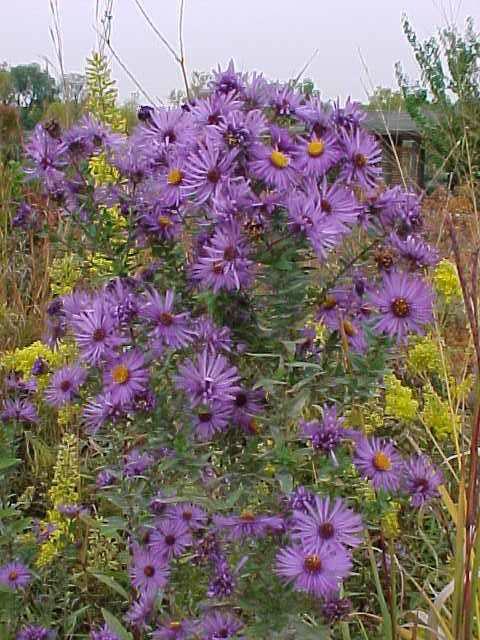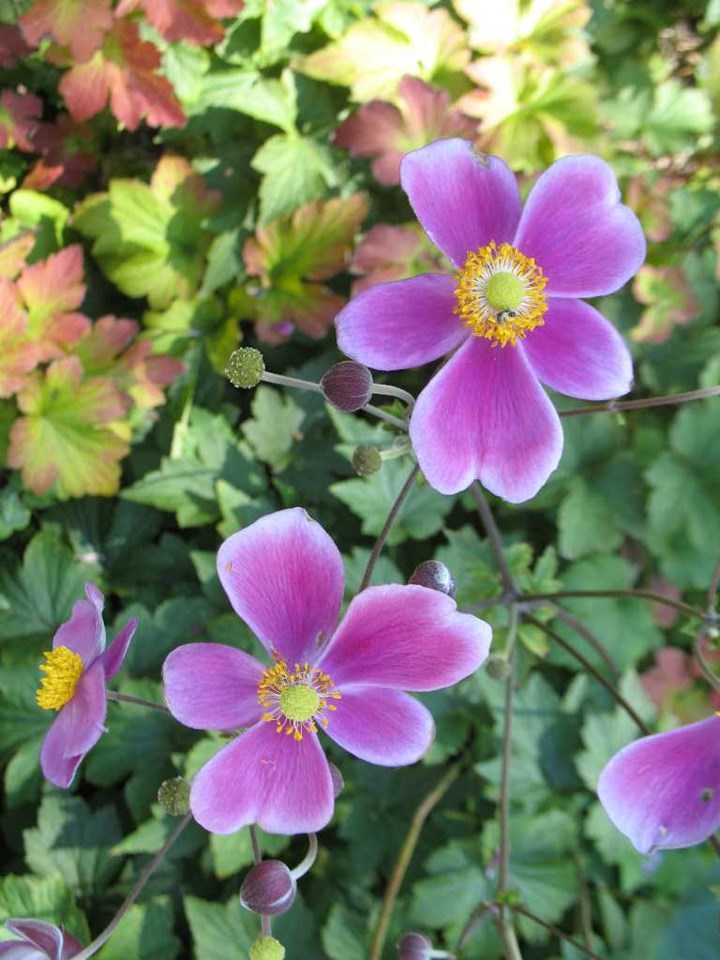
Welcome to Gardens By Danielle's blog! The blog will provide readers with tips and tricks for all things garden related, as well as give timely tips once a month. We hope you enjoy it!
Timely Tips...
In the Philadelphia area, its time to start putting your garden to bed for the winter. This means pulling up annuals and cutting back perennials to the ground. The annuals and perennials will die back in the next couple of weeks after we start getting hard frosts. Some people prefer to leave the perennials until the spring and then cut back the old, dead growth then. You'll also want to spread leaves or compost over your vegetable garden and other garden beds. Some people prefer to put mulch down instead, but this is not completely necessary.
This month, its also time to start forcing flower bulbs indoors. Some of the most popular bulbs for forcing indoors are Paperwhites and Amaryllis. When started now, they will bloom in time for the holidays. Some people also like to force spring blooming bulbs like, Daffodils, Tulips, Hyacinths, Crocus, and Iris indoors also. Spring blooming bulbs need to be pre-chilled for several weeks before being forced indoors. This fools the plant into thinking its spring, so it will then bloom indoors during the winter. These bulbs can then be planted outside in the spring.
Paperwhites and Amaryllis don't require pre-chilling since they are tropical. Paperwhites are tall and thin with lots of small, white, daffodil-like flowers that are fragrant. Amaryllis have 1-2 stalks with 4 large flowers per stalk. They come in orange, pink, red, white and bicolors. Amaryllis and Paperwhite both need to be staked when they get tall or they can tip or lean over. Paperwhites bloom 4-6 weeks after being planted and Amaryllis bloom in 8-10 weeks after planting.
Paperwhites can be planted in soil or in a vase in fine river stones or gravel. They need to be planted with their crowns exposed if planted in gravel. Place them in a sunny window and water whenever the soil dries out. If the Paperwhites are planted in gravel, keep the water level up to the bottom of the bulbs.
Paperwhites (Photo Courtesy of White Flower Farm)
Amaryllis can also be planted in soil or river gravel. When Amaryllis are planted in soil or river stones, they should only be buried with their crowns and 1/4 from the top of the crown exposed. Some of my favorite cultivars are 'Apple Blossom' and 'Ferrari.' 'Apple Blossom' has blooms that are a light pink and white. 'Ferrari' has bright cherry red blooms. Amaryllis should only be watered when they dry out almost completely when planted in soil and the water level should be maintained right under the surface of the stones when grown in stones. Don't overwater or the bulbs will rot. Amaryllis bulbs will re-bloom next year if treated in a certain manner after blooming or you can start with new bulbs every year.
Amaryllis 'Apple Blossom' (Photo Courtesy of: White Flower Farm)
Amaryllis 'Ferrari' (Photo Courtesy of: White Flower Farm)
I hope these tips help to bring some color and beauty during the dark, grey days of winter.
Timely Tips...
The ideal time to plant spring blooming bulbs in this area is the fall between now and mid November. Spring blooming bulbs include Crocus, Daffodils, Tulips, Hyacinths, and Iris. This is because these bulbs need the entire winter to go through a chilling process, which will enable them to bloom in the spring. Crocus are usually the first to bloom, usually in late winter to early spring, depending on the cultivar. Daffodils are the next to bloom, followed by tulips, hyacinths and iris. Spring bulbs come in a whole rainbow of colors, variety of shapes and some are even fragrant. Here are some planting tips to help you get started:
-Plant in groups of 3-5, which will give more impact when they sprout.
-Use starter fertilizer when planting. You can add it to the hole when you plant. I like to use Epsoma Bulb Tone, but any balanced fertilizer that contains bone meal is good.
-Plant as soon as possible after your bulbs arrive and follow all planting instructions.
Where to Buy: I like purchasing bulbs from mail order sources, because you can get higher quantities, better quality bulbs and more selection of varieties than if you buy from a local garden center or a big box store. I will list reputable sources for mail order bulbs below.
Here are some of my favorite cultivars of spring blooming bulbs:
Crocus chrysanthus 'Advance'- Color: Yellow & Purple Height: 0-6" Full sun-part shade Bloom Time: Winter-Very early Spring
Crocus 'Orange Monarch'- Color: Orange Height: 0-6" Full sun Bloom Time: Very early spring
Narcissus 'Accent'- Daffodil- Color: Orange center and white petals Bloom Time: Mid Spring Full sun-part shade Height: 13-18"
Narcissus 'Dutch Master'- Daffodil- Color: Yellow Full sun-part shade Bloom Time: Early-mid spring Height: 13-18"
Hyacinthus orientalis 'Blue Jacket'- Hyacinth Color: Blue Bloom Time: Early-mid spring Full-part sun Height: 7-12"
Hyacinthus orientalis 'Pink Pearl'- Hyacinth Color: Pink Bloom Time: Early to mid spring Full sun-part shade Height: 7-12"
Iris (Dutch) 'Rendez Vous'- Color: Purple and Yellow Bloom Time: late spring Full sun Height: 19-24"
Iris (Dutch) 'Mystic Beauty'- Color: Purple and Yellow Bloom Time: Late Spring Full sun Height: 19-24"
Tulipa 'Beauty of Apeldoorn'- Tulip- Color: Red & Yellow Bloom Time: Mid spring Full sun Height: 13-24"
Tulipa 'Burning Heart'- Tulip- Color: Red, white and yellow Bloom Time: Mid spring Full sun Height: 13-24"
This is also a good time of year to cut back (to the ground) any perennials that are starting to die Bach or look brown. This is mainly spring and summer blooming perennials. The rest can be cut back next month.
Mail Order Sources for Spring Blooming Bulbs:
Brent & Becky's Bulbs: http://www.brentandbeckysbulbs.com/
Breck's Premium Flower Bulbs: http://www.brecks.com/
Timely Tips...
This time of year, gardens often start looking tired as the blooms of summer fade and die back. It's the end of the growing season for a lot of summer blooming plants. Fortunately, there are bulbs, annuals, and perennials that bloom in the fall and thrive in the cooler air. In this post, I will talk about some common (and maybe not so common) fall blooming annuals, perennials, and bulbs to add color to your garden during the cooler months of fall.
Annuals:
Viola x wittrockiana- Pansy- This annual is a member of the Violaceae (Violet) family and thrives in cool weather. It flowers throughout the fall until the first heavy frost. Flowers can be single or double and come in blue, purple, red, rose, yellow, apricot, maroon, white and bicolors. Pansies grow to 1/2-3/4" tall with a spread of 3/4"-1'. They thrive in full sun to part shade, attract butterflies and are edible. These colorful bedding plants are great for planting in the ground or containers.
Viola x wittrockiana- Pansy (Photograph Courtesy of: Missouri Botanical Garden)
Brassica oleracea- Ornamental Cabbage- Ornamental or Flowering Cabbage adds great color to the fall garden and thrives in cooler weather. It grows to a height of 1-1 1/2' tall and a spread of 1-1 1/2'. Plants are green, white, and different shades of pink and purple. They thrive in full sun and are great in the ground or seasonal containers.
Brassica oleracea- Ornamental Cabbage (Photograph Courtesy of: Missouri Botanical Garden)
Dendranthema x grandiflora- Chrysanthemum- Chrysanthemum, commonly called "Mums" are great plants for the fall garden or containers. They are bushy plants, full of small-large, daisy-like blooms, The flowers come in brown, red, white, yellow, pink, and red-orange. Other benefits of mums is that they attract butterflies and can be used for cut flowers. Mums grow to 1-2' tall and have a spread of 1-2'. These fall beauties grow well in part sun to part shade. Note: There are also perennial varieties, too.
Dendranthema x grandiflora- Chrysanthemum (Photograph Courtesy of: The Garden Helper)
Bulbs:
Colchicum byzantium- Autumn Crocus- When most people think of crocus, they think of bulbs that bloom in early spring, but there are also crocuses that bloom in the fall also. Crocus come in varying shades of pink and purple and bloom September-October. They grow to a height of 1/4-1/2" tall and have a 1/4-1/2" spread. These bulbs grow best in full sun to part shade and need to be planted in August.
Colchicum byzantium- Autumn Crocus (Photograph Courtesy of: Breck's)
Cyclamen hederiflolium- Hardy Cyclamen- Cyclamen are often thought of as an indoor plant that are grown in greenhouses and windowsills, but there is a variety of cyclamens that thrives in this area. This variety comes back every year and blooms in the fall. These beauties grow to a height of 4-6" and do well in part to full shade. The blooms come in colors of rose-pink and the foliage is heart shaped. Great for shade gardens!
Cyclamen hederifolium- Hardy Cyclamen (Photograph Courtesy of: Breck's)
Perennials:
Symphyotrichum novae-angliae- New England Aster- This type of Aster is native to this area and blooms August-September. The blooms are daisy-like and a deep pink-purple color. They grow to 3-6' in height and have a spread of 2-3'. New England Aster requires full sun and attracts butterflies.
Symphyotrichum novae-angliae- New England Aster (Photograph Courtesy of: Missouri Botanical Garden)
Anemone hupehensis- Japanese Anemone- These lovely flowers grow to a height of 2-3' tall and have a 2-3' spread. Japanese Anemone bloom August-September and the petals are rose-pink with yellow centers. They require full sun to part shade.
Anemone hupehensis- Japanese Anemone (Photograph Courtesy of: Missouri Botanical Garden)
I hope these plants help to brighten your garden this fall and keep your spirits up with summer being over. Stay tuned for the next post.
Sources:
Missouri Botanical Garden: Plant Finder. www.missouribotanicalgarden.org
Dendranthema x grandiflora: Chrysanthemum. University of Florida IFAS Extension. Edward F . Gillman. Copyright: October 1999. 7, September 2017.
Breck's. www.brecks.com
Timely Tips...
During the month of July, the growth of plants usually slows down because of the weather being hot. However, weed growth is still rampant and at times, it may seem like your losing a battle with them. Here in Pennsylvania, there are so many weeds that can be extremely hard to pull and grow rapidly. A lot of these weeds are invasive and can have long taproots or underground bulbs or tubers that can be a challenge to dig out of the soil. To make matters worse, weed seeds can be scattered by the wind, rain and by birds. Even seedlings of trees and shrubs can be considered weeds if they germinate in the middle of plants or perennial beds. This month's post is about weed control, so that you can enjoy a weed free garden. I will be listing several methods of weed control with descriptions of each.
Method 1: By far, the best method for removing and controlling weeds is by hand. In order to get the most out of it, try to remove as much of the roots and/or bulbs/tubers as possible. If you weed a day or two after it rains, the weeds will come out easier. For weeds with really long taproots, like Dandelions, use a dandelion digger to pry out the taproot with. You can also use something called a weeding knife, which is a tool that allows you to cut, dig and lift all with one tool. This tool is also great for removing weeds with underground bulbs or tubers since you can dig down deep and lift them out. Another great tool for removing weeds with is a weed weasel. With this tool, you can really loosen the soil around the weeds a lot, which will make getting them out easier. This is especially good for large areas of weeds. For smaller weeds, you can use a tool with a curved blade (it kind of looks like a miniature sickle) to cut them off at the base.
Method 2: If you have a large area of weeds, a weed whacker that is gas or electric powered can be used. You can also use a lawn mower to mow them down with, but make sure the weeds aren't too tall or you'll damage the mower.
Method 3: The most effective method of weed control that I have found is planting plants close together or allowing plants to fill in. Right after weeding is a good time to plant more plants so that the weeds don't have a chance to get established. Gardens that have just plants and no open soil space get fewer weeds than gardens that have open soil space. This is because the plants shade the weeds out and starve them of essential water and nutrients.
Method 4: Another really great method for weed control is placing several layers of newspaper (pages with black ink only), cardboard, or biodegradable fabric with 2-3" of mulch or wood chips on top. This method is great for large areas and works by choking the weeds out using suffocation and heat. You can also place a tarp over a large area where you want to kill the weeds in, which will suffocate the weeds and bake them. You'll want to leave it in place for 2-4 weeks. I don't recommend using landscape fabric, as this is not biodegradable and can be really hard to plant plants in.
Method 5: For weeds that come up in walkways and patios, a great method is a weed torch. This is a handheld torch fueled by propane or some other fuel that allows you to burn the weeds.
Method 6: I purposefully put this method last, because it should be used as a last resort when all other methods fail. I also strongly discourage it. Chemical weed killers can be used to kill weeds with, but this causes pollution. A lot of chemicals used in weed killers can be very dangerous to any person or animal that comes into contact with it. Even if the chemical says it only kills the leaves and stems of weeds and will dissipate, this is not always true. A lot of these chemicals can leach into ground water, which can then end up in our drinking water supply. This can kill off or cause health problems in people or animals who then drink this water. Also, some weeds can develop a resistance to some of these chemicals, which could mean that they may not be as effective. If you choose this method, PLEASE READ AND FOLLOW ALL DIRECTIONS AND PRECAUTIONS PRINTED ON THE LABEL! PLEASE USE PROPER SAFETY GEAR AND PRECAUTIONS WHEN SPRAYING WEED KILLERS AND DISPOSE OF EXCESS PROPERLY! There are organic and homemade weed killers made from household items, but these have to be used more often and aren't as effective. Organic weed killers are also more expensive.
Timely Tips...
June is the perfect time of year to plant tropical and subtropical plants in your outdoor garden to use as accent plants. I love adding a tropical feel to an ordinary garden with trees, shrubs, annuals and perennials. Tropical plants make great accent and focal plants, as well as providing splashes of color and making your landscape pop. People usually don't think about adding tropical plants to their gardens, but these plants look great in amongst temperate plants. These plants can either be used as annuals in this area or overwintered inside during the fall and winter and replanted in the spring. Whatever your preference is, is fine. In this post, I will discuss 6 of my favorite tropical plants to use in the garden.
Canna 'Tropicanna' (Photo Courtesy of: American Meadows)
Canna Lily
Canna Lilies can be grown from either rhizomes or already started plants. The foliage of these plants has a great tropical feel and come in colors of green, green with yellow variegation, or dark purple. They have clusters of brightly colored flowers at the tops of the plants from summer to fall. The flowers come in yellow, red, orange and pink or a mixture of these. My favorite cultivar is 'Cleopatra,' which has bright yellow and red flowers. Cannas can grow up to 4' tall and require full sun and are tolerant of wet feet. They can be grown in regular garden beds, or soggy soil and ponds. They require high to moderate amounts of fertilizer during the growing season and can tolerate a minimum temperature of 35 degrees Fahrenheit. The rhizomes can be overwintered inside, after all of the foliage is cut off and they have dried out a bit. The rhizomes should be stored in paper bags in spagnum moss or wood shavings in a cool, dark place that is free of frost.
Colocasia gigantea 'Thailand Giant' (Photo Courtesy of: Plant Delights Nursery)
Colocasia- Elephant Ears
Colocasia are tropical foliage plants with large heart shaped or elephant ear shaped leaves, hence this plant's common name. The leaves can get up to 48" across! The foliage comes in light or lime green, green, dark green, or dark purple. Colocasia grow to be 5-7' tall and can either be grown from bulbs or already grown plants. They can tolerate full sun, part sun, or shade, but prefer higher light levels. These plants require large amounts of water and fertilizer during the growing season and can tolerate wet feet, so they make good pond plants, too. Colocasia can tolerate short periods of dryness as long as its not severe. Tolerant of a minimum of 50 degrees Fahrenheit. These plants can make good potted plants inside your home in the fall and winter, where if they like where they are growing, will continue to grow, otherwise, they will lose their leaves and go dormant. If this happens, leave the bulb in the pot and stop watering until the spring and leave the pot indoors in a frost free area.
Cordyline terminalis (Photo Courtesy of: Plant Info)
Cordyline terminalis- Hawaiian Ti Plant
The Hawaiian Ti Plant is known for their long leaves and bright colors on the foliage rather than flowers. The foliage comes in colors of green with white, purple and pink streaks or yellow with white and brown streaks. Cordyline prefers full sun, part shade or shade and grows to 1-2' tall. Under high temperatures and light, they require moderate fertilization during the growing season. Tolerant of temperatures above 50 degrees fahrenheit. Cordyline can be allowed to die back in the fall or can be potted up as a houseplant over the fall and winter indoors.
Datura metel 'Belle Blanche' (Photo Courtesy of: White Flower Farm)
Datura metel- Horn of Plenty
Datura can be grown quite easily from seed or start and is usually used as an annual in this area. CAUTION: ALL PARTS OF THIS PLANT ARE POISONOUS! There are single flower and double flower varieties, which come in white, pastel yellow and purple. Horn of Plenty blooms from spring-fall and reaches 2-3' tall. This plant requires full sun and can tolerate a minimum temperature of 55 degrees fahrenheit.
Mandevilla (Photo Courtesy of: Garden Know How)
Mandevilla
Mandevilla is a vining plant that can reach 3' long. It looks great, either in a pot or in the ground growing on a trellis. The foliage is dark green and shiny. The flowers come in white, dark and light pink and this plant prefers full sun and a Southern exposure. The blooming season for this plant is summer and it can tolerate temperatures above 60 degrees fahrenheit.
Musa acuminata (Photo Courtesy of: Useful Tropical Plants)
Musa acuminata- Banana
Banana plants just scream tropical with their large green leaves and thick herbaceous stalks. Musa prefers full sun, but can tolerate part sun, too. These plants love sunny, hot and humid weather, which makes them great for Philadelphia summers. They require high amounts of water and fertilizer during the growing season and shouldn't be allowed to dry out. Musa can tolerate a minimum of 60 degrees Fahrenheit. The leaves get really large and the plants can get up to 5' tall or taller, depending on the species and cultivar. Sometimes these plants even fruit! Musa can be allowed to die back in the fall or grown as an indoor houseplant if you have the space.
Bibliography: Logee's Plants for Home and Gardens: "From the Grower: Care" https://www.logees.com/
Timely Tips...
Spring is a busy time in the garden and the month of April is no exception. Here is a list of tasks that should be done this month, which I will be talking about in this post:
Dividing and transplanting hardy perennials, such as: Heuchera, Daisies, Hellebore, and Hosta
Cleaning up dead plant debris from around plants
Starting a compost pile
Building and prepping raised beds for planting
Installing supports/stakes for plants like Peonies
Giving flowering bulbs and tubers a head start indoors, examples include: Cannas, Dahlias, Caladiums, Begonias, Lilies, etc.
Cutting back last year's growth on Hellebores
Installing a trellis for peas
Planting asparagus
Divide and Transplant Hardy Perennials: This month, hardy perennials, such as Daisies, Hellebore, Hosta, and Heuchera can be divided and transplanted. The entire clump should be dug up before the next step can take place. This can be done with a sharp shovel. You can slice the plant right down the middle of the crown to cut it into half or into quarters, depending on how large the clump is. The divisions can either be transplanted into other areas of your yard or shared with neighbors, friends or family.
Clean Up Dead Plant Debris From Around Plants: If you haven't already done this task in the fall, it should be done now, before a lot of the new growth starts to sprout and grow. Sometimes, you can just do this by pulling it away with your hands, other times this task will require scissors or pruners to trim the old, dead foliage away. This is really important to prevent diseases, pests, and fungi which can cause problems with your plants when they start to grow new growth during the growing season.
Start a Compost Pile: There are many benefits of having your own compost pile. Compost can provide your plants with nutrient rich, organic fertilizer and mulch. Another important benefit of a compost pile is that it is sustainable, since your garden waste and food scraps can be discarded in it, where they decompose and become quality soil for use in your garden. These are just a few of the many benefits of compost. You can either devote a corner or area of your yard for compost or build your own compost bin out of almost any type of material. I have seen compost bins built out of cinderblocks stacked on top of each other, wooden pallets used for shipping, lumber, chicken wire and lots of other materials found around your house or at the local hardware store. There are also ready-made metal or plastic compost bins on the market, that have cranks that make turning and mixing your compost easier, though these are not necessary. You will need to position the compost pile in a shady area of your yard, so it can heat up to the proper temperature for decomposition. You can put things like leaves, grass clippings, fruit and vegetable peels, cores, and scraps, dead plant material and other forms of yard waste in the compost pile. Just don't use weeds, since weeds can start growing in a compost pile and take over. You will need to turn or mix your compost every now and then, so you may not want to make your compost pile too large. Here are some compost recipes and building plans to get you started: https://www.epa.gov/
http://www.motherearthnews.com/
Build and Prepare Raised Beds: Raised beds are an excellent idea for people who have trouble bending over or kneeling, since raised beds are simply that: garden beds that are higher than ground level. Seniors and physically challenged people can still enjoy gardening without having to bend over or kneel down. The other great benefit of raised beds is that if you have poor or contaminated soil, you can still do well with gardening or growing your own food since you can fill a raised bed with top soil or any soil mix. (or better yet, compost!) Raised beds can be made of wood or plastic. Here are some great resources with building plans and tips on raised beds to get you started: http://www.rodalesorganiclife.com/ http://www.almanac.com/
Install Stakes/Supports: This time of year is also great to stick wooden or bamboo stakes or supports in the ground near plants like Peonies. You can even use sticks and branches found around your yard for a more natural look. Later on the plants will need the supports to lean on and to support them when they start growing and blooming. You can also buy special wire supports made for Peonies and other types of plants that are placed over where the plant is growing. The plant then grows up through the support.
Start Summer Flowering Bulbs Indoors: Summer flowering bulbs and tubers like Canna, Dahlias, Begonias, Caladiums, Lilies, etc. can be given a head start by starting them indoors before planting them outside in May. They will bloom sooner and have a head start. This is optional, as these can also be planted directly in the ground outside after the danger of frost has passed. You will need a good quality, well draining potting soil without moisture retention crystals or fertilizer in it. You will also need 6" pots. Plant one bulb or tuber per 6" pot, water well, but don't soak and place in a windowsill. Follow the instructions on the depth to plant the bulbs and tubers with the literature that came with them.
Cut Back Last Year's Growth: On plants like Hellebores that hold onto their leaves year around can have old growth that drops to the ground, has dead spots and looks unsightly this time of year. There will most likely be new, green growth and flowers or buds coming up from the middle, you'll want to leave those. Just cut back the old, unsightly growth of last year as close to the base of the plant as you can.
Install a Trellis for Peas: In the vegetable garden, plants that you planted earlier this spring, like peas will grow tall and will eventually need support. To give the plants this support, they will need a trellis to lean on and grow up. These can be bought or built from wood, bamboo or metal poles. Here are some links to DIY trellis plans to get you started: http://www.bhg.com/
Plant Asparagus: Asparagus is a crop that takes 2 years before it begins to produce asparagus. It is a crop that needs its own bed as it can spread and get rather large. It can either be planted as seeds or crowns. I recommend planting crowns, as it takes a lot less time to grow then from seed. Here are some links that explain how to plant asparagus and give good tips: http://www.rodalesorganiclife.com/garden/how-grow-asparas http://www.almanac.com/
Happy Gardening and Stay Tuned for Next Month's Post!
Timely Tips...
Its that time of year again to start seeds for the spring! In order to have vegetable, herb, annual and perennial seedlings ready to plant in time, you need to plant them now. Here are some benefits of starting plants from seed:
You have more varieties to choose from
It costs less to start seeds than to buy already started plants
You can be sure that your herbs and vegetables are grown organically right from the start
Its fun! Its the perfect educational project for children!
Vegetables:
Cooler weather vegetables or vegetables that prefer growing in cooler weather like during spring and fall benefit from getting a head start indoors. These plants are usually planted outside in the garden in early to mid March in the Philadelphia area. Cooler weather vegetables include:
lettuce- leaf and head
broccoli
spinach
carrots
radishes
beets
peas
cauliflower
cabbage
kale
If you like, these can be direct seeded out in the garden in early to mid March, but may need protection if it goes down to freezing at night. (I'll talk more about that in the next Timely Tips in March). These seeds need to be started now. Successive sowing every 2-3 weeks can help to ensure you get a regular harvest.
Warm weather vegetables are those that prefer warmer temperatures and are planted after the danger of frost, which is usually the end of April or beginning of May in this area. Warm weather vegetables include:
Tomatoes
Peppers
Eggplant
Green Beans
Cucumber
Squash
Zucchini
Okra
Seeds of these vegetables also benefit from being started indoors before the last frost. Tomatoes, peppers and eggplant need to be started about 6-8 weeks before the last frost date. Green beans can be directly seeded. Cucumber, squash, and zucchini can be started 2-4 weeks before the last frost date, since they grow faster. These can also be directly seeded in the ground. Remember to harden off all seedlings before planting them in the garden. (I'll talk more about this in the next issue of Timely Tips). For these seeds, wait a couple more weeks before starting them. A good rule of thumb is to count backwards from the last frost date for your area.
Herbs:
Most herb seedlings also benefit from being started indoors also. Here is a list of herbs that should be started indoors:
Basil
Parsley
Sage
Chives
Thyme
Oregano
Lavender
Sweet Marjoram
Lemon Balm
Herb seeds need to be started now, since they need at least 10-12 weeks to develop into nice sized starts before being planted outside after the danger of frost.
Flowers:
A lot of flower seeds need to be started indoors also. Annuals that need at least 10-12 weeks to develop before the last frost date include: pansies, petunias, impatiens, and snapdragons. Annuals that need 4-6 weeks to grow indoors before the last frost include: marigolds, nasturtiums, four o'clocks, and sunflowers. Be sure to look at the germination time on the backs of the packets of seed and take the germination time into consideration when deciding when to start the seeds indoors also. Perennial seeds also benefit from being started indoors.
Tips for starting seeds indoors:
Container: Be sure to use seed starting trays with drainage in the bottom.
Soil: Any soil that is used for germinating seeds needs to be well draining, light in weight and loose. Don't use soil from outside. I like to use soil less mixtures like Pro-Mix and Organic Mechanics.
Light: Some seedlings need light to germinate and others need darkness to germinate, be sure to refer to the back of the seed packet for details. Once they are germinated, most seedlings require a good bit of light. To achieve this, you can either put them in a sunny east, west or south facing window or in a sunroom, if you are fortunate enough to have one. If you don't have a sunny enough window, you can use supplemental lighting like fluorescent lights. You can either buy shop lights fixtures at your local hardware store and set up your own light stand or you can buy a plant light stand with multiple shelves and lights on a rolling cart. Be sure to get fluorescent bulbs that are either "full spectrum" or "daylight"- 65,000 K. These bulbs mimic natural sunlight as much as possible. In order to get good results, the lights must be positioned 2" above the tops of the plants. This will prevent the plants from getting leggy and reaching for the light. If the seedlings are in the windowsill, remember to rotate them often, so that they grow straight. The lights will need to be on for 10-12 hours a day. A good way to accomplish this is with a timer.
Water/Humidity: Germinating seeds need a moist, but not soggy growing medium. They also require somewhat high humidity. When you plant your seeds, place the trays in a shallow container of water, so that they wick up the water through their drainage holes until the growing medium is evenly moist, but not soggy. Or you can mist the surface of the soil lightly, as long as the seeds are buried under the soil so they don't go flying when you mist them. If they are surface planted, bottom watering is better. To keep the seed trays from drying out and to keep the humidity level moderately high, cover them with plastic domes available at your local garden center. Remember to remove the plastic cover when the seeds germinate.
Temperature: Seeds require temperatures ranging from 68-75 degrees Fahrenheit to germinate. The warmer it is, the quicker they germinate. Most of the time, normal room temperature (68-72 degrees Fahrenheit) is fine. Also, fluorescent lights put off some heat, too. If you keep your house cooler, than you may need a seedling heat mat. These are rubber mats that get placed below the seed trays and heat the soil to around 70-74 degrees Fahrenheit.
Fertilizing: Be sure to fertilize your seedlings 2-3 weeks after they germinate. You should fertilize every other or every third watering. I like to use organic fertilizers like Neptune's Harvest, Plant Tone or Vegetable Tone.
Stay tuned for the March issue of Timely Tips! Happy Gardening!
Sources for seeds, seed starting supplies, and equipment:
Local: Primex Garden Center, Glenside, PA www.primexgardencenter.com
Mail Order: Johnny's Selected Seeds http://www.johnnyseeds.com/ , Select Seeds http://www.selectseeds.com/ , Burpee Seed Co. http://www.burpee.com/ , J.W. Jung Seed http://www.jungseed.com/ , Seed Savers Exchange http://www.seedsavers.org/


